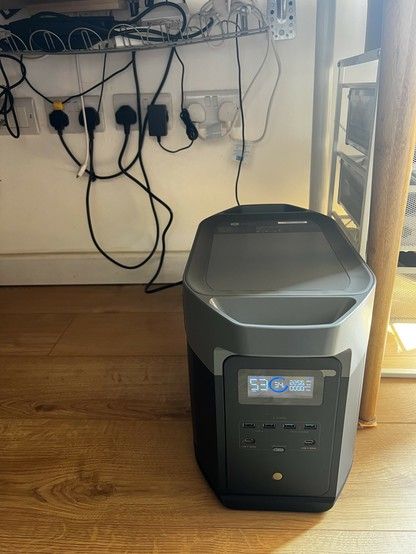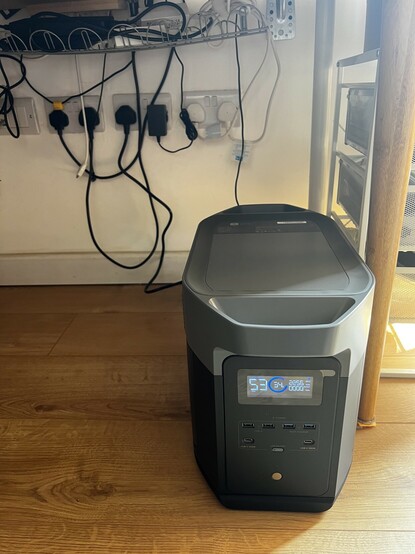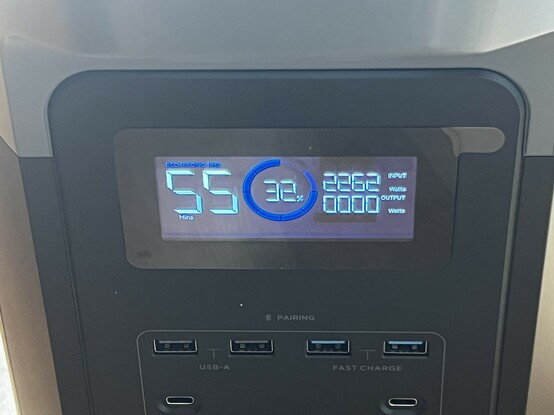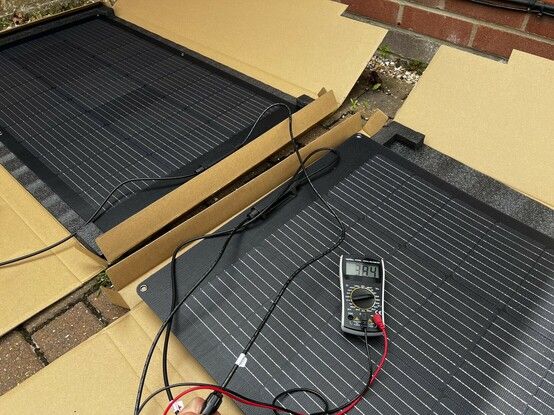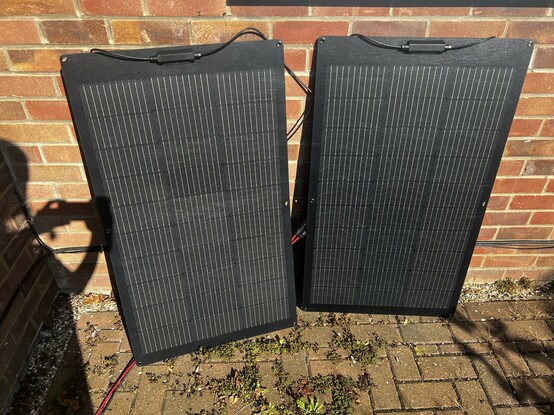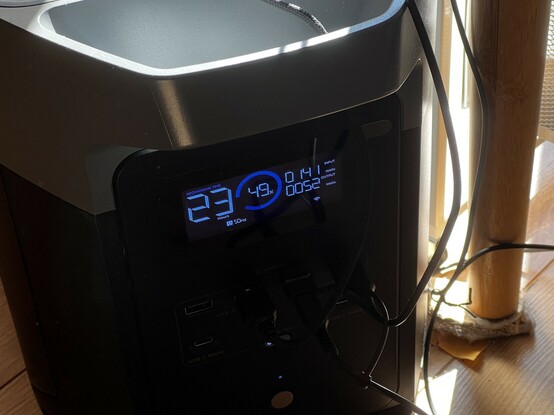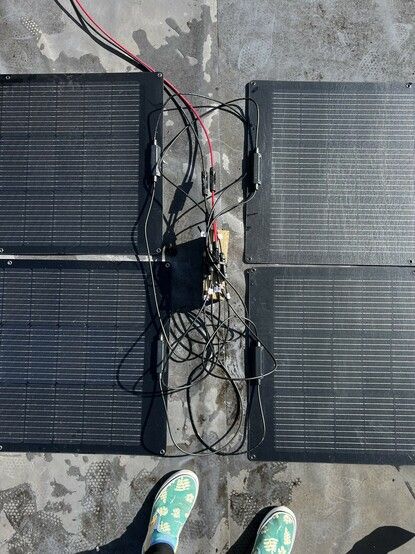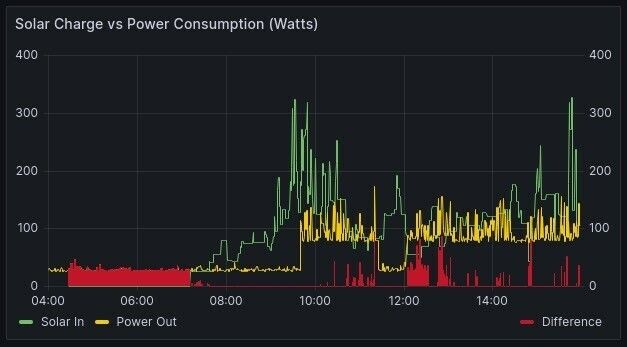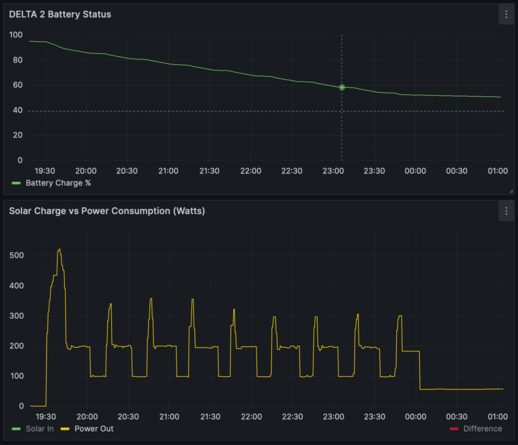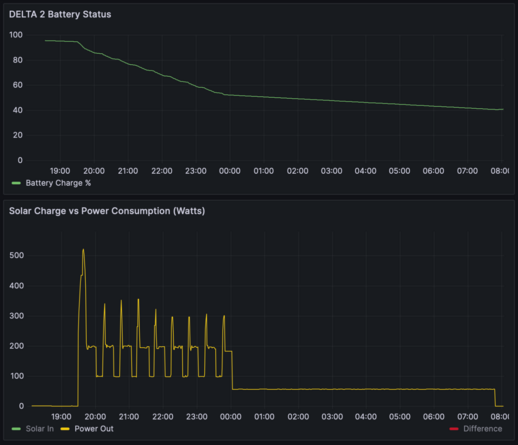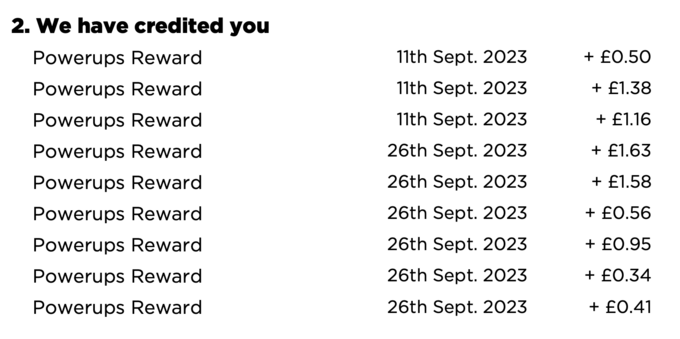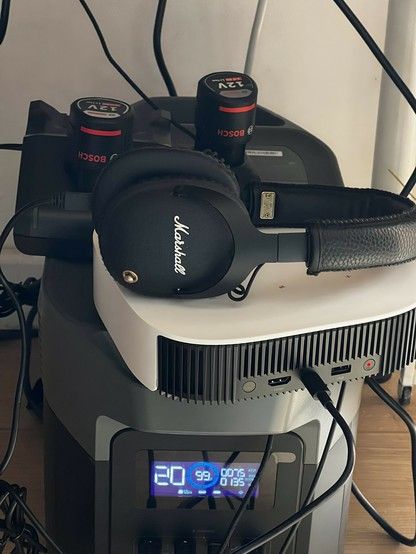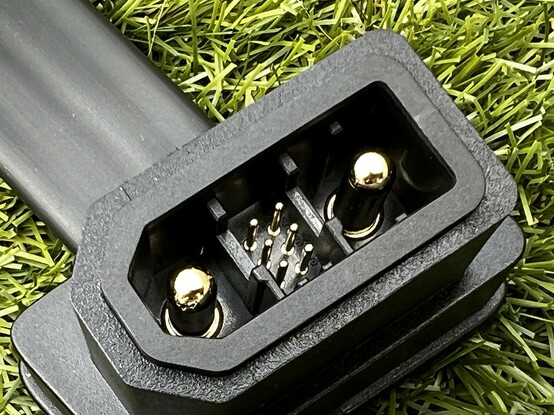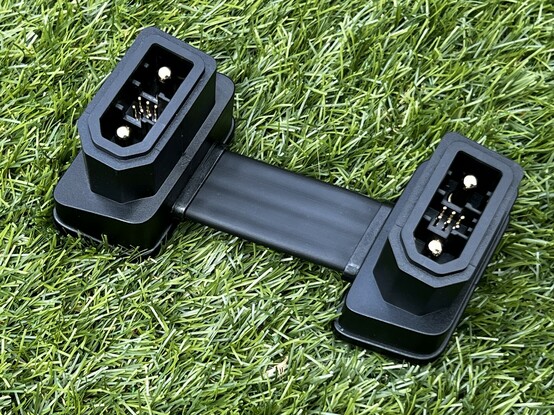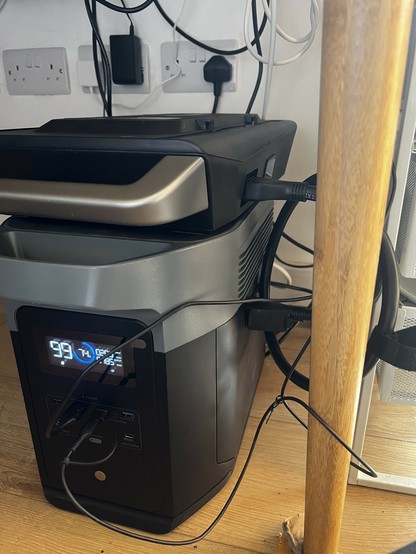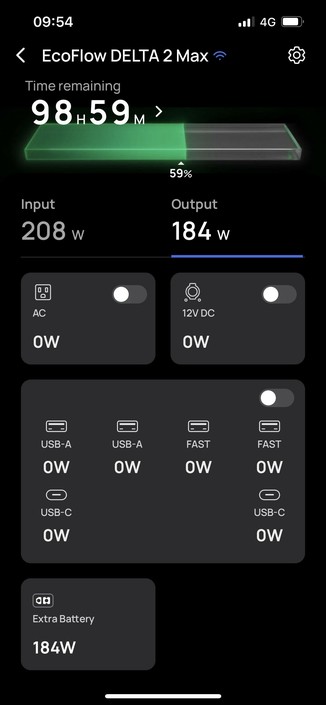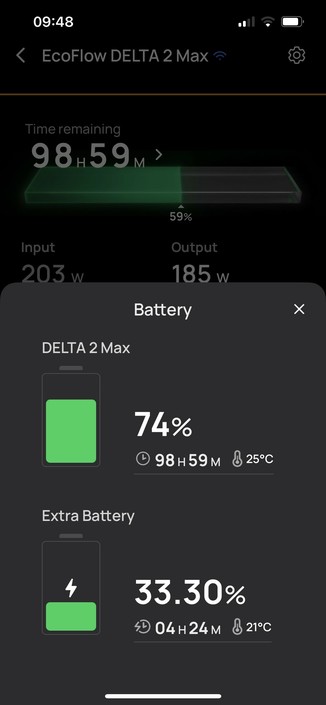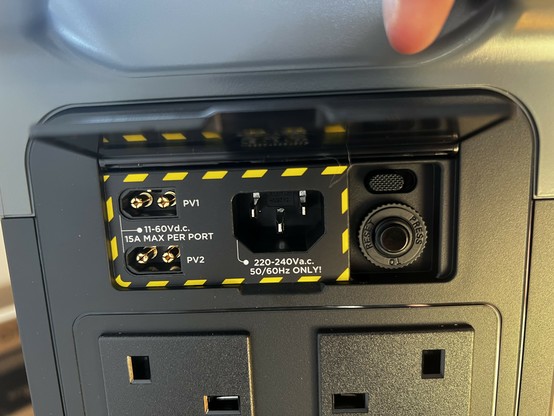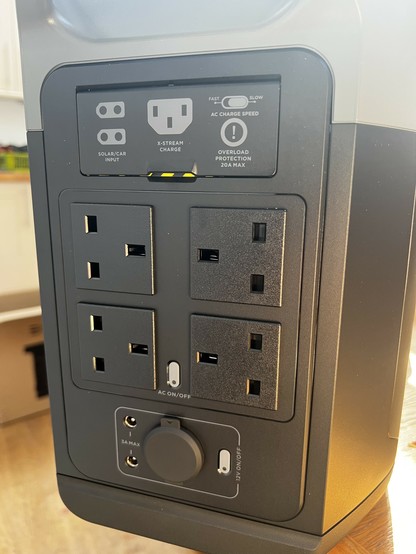EcoFlow DELTA 2 Max Review
I’ve been running the EcoFlow DELTA 2 Max in my office for more than four months as I slowly piece together what my off-grid office setup might look like and how feasible it could be.
In short the DELTA 2 Max is far from the weakest link in the equation. It will happily run my workstation for a day or two. The British weather, on the other hand, does not seem willing to cooperate with sufficient sunlight to recharge after that day or two has passed.
About the size of a regular desktop PC, little chonkier but it’s been relatively unobtrusive under my desk and a great place to pick up USB power if I need it.
At first I had just the DELTA 2 Max installed, but this was followed more recently by 400W of solar capacity in the form of four of EcoFlow’s 100W flexible panels. 400W is not sufficient to run my office, at least not in most cases, but it has demonstrated the ability to peak beyond 400W of actual generation capacity and – occasionally – I find myself with ample sun and a full battery. The ideal solution here is to add grid export to the equation, but that’s not something I’m keen to do- the process of certification is onerous and costly and… well… if I connect to the grid, it’s not really off-grid is it.
Juicing up the EcoFlow DELTA 2 Max. It’s a 2048Wh monster! My office currently runs from a 20A car charging circuit, disabling the charger, I’m hoping to switch to solar but first I’m testing this hulk! Maybe I can load shift?
More recently Octopus Energy have started their “Power-ups” scheme, where a two hour slot in a given day – when the grid has some extra capacity that needs using – might be nominated for “free energy”. This has given me a second source of power to recharge DELTA 2 Max.
Anyway, at the risk of this review becoming another blog post about my off-grid office setup I should probably talk about the merits of EcoFlow’s DELTA 2 Max, which forms the heart of the whole setup.
Solar
The DELTA 2 Max is first and foremost a portable power supply and energy storage solution, intended to be used to give a camper van, van conversion or other form roaming home the means to generate electricity from solar and be, more or less, self sustaining. It does this brilliantly well, offering up to 800W of solar input by means of two XT60i ports. You’ll need to note the “i” at the end of XT60i there, the DELTA 2 Max requires connectors with a mystery third pin that, as far as I can tell, is simply tied to ground since the MC4 solar panel connectors that it adapts do not have any useful sense line. Because I received solar panels from EcoFlow rather out of the blue, I had to grapple for suitable cables on Amazon. I opted for 4mm squared cross section core MC4 cables since the larger 6mm were pricy and probably quite spectacularly over specified for my humble 400W installation.
I don’t have the right cables to connect these 100w flexible panels from EcoFlow up yet, so I’m checking the magic sun pixies are working!
Connecting up panels is easy, though you need to ensure careful placement and avoid situations where one panel might be shaded since this brings the whole capacity of the system down dramatically. Solar is only as good as the weakest link. I decided to wire my four panels in a series/parallel configuration with a parallel pair set of two panels in series. This involved a set of MC4 Y splitters, 3m of MC4 extension cable and a 1.5m XT60i to MC4 adapter cable. Notably this cable was 12awg which conversion tables tell me is 4mm squared, that 6mm cable really would have been a waste of money. Be careful out there.
The solar saga continues. I leaned a couple of panels up against the wall facing roughly into the sun. This is 200W capacity putting out ~140W. Not bad for a no-effort setup. Also proves the cables I ordered work.
Once connected I ran my panels for a few days propped up against the wall, taking them inside at night to get a feel for what sort of energy production I could expect. EcoFlow’s flexible panels are – comparatively anyway – light and quite considerably more forgiving than rigid panels. Once I had finally drilled a hole through my office wall for the XT60i cable (quite an adventure with a 12v drill and a 10mm masonry bit) I simply stacked the four panels on top of each other and hefted them up onto my office roof with a step stool. Just spacing them out and laying them flat was sufficient to get anywhere from 50W to 450W depending on sunshine, cloud cover and temperature.
Flexible solar panels tossed up onto a flat roof actually work reasonably well. Since they’re light weight and take a little bit of bending in their stride I could stack the lot up and heft them into the roof by myself. Now I’ve tidied up the cables and kept them out of standing water by zip-tying them to a brick.
While solar energy is generated, the DELTA 2 Max will power external devices – connected to AC, 12v or USB – from solar capacity, drawing any necessary additional power from the battery. If you generate more solar than you consume, it’ll charge the battery. If you generate less it will discharge the battery. Simple. More battery capacity gives you more opportunity to balance excess solar power with peak consumption and more solar generation lets you charge quicker. It’s a delicate balance, and I don’t have a trick or formula to figure out how much solar capacity you should pick to satisfy off-grid generation without generating overage that you can’t export to the grid. I can only suggest you start small and work up as the need arises.
EcoFlow’s app provides relatively high level information about solar input and power output, you can see right-now figures with no history information which is a little underwhelming. There’s not much point generating solar energy if you can’t collectively share graphs and moan about how the weather keeps leaving you at an energy deficit.
I solved the lack-of-graphs problem by tapping into EcoFlow’s MQTT server, which provides the backbone for communication between their devices and their app. It’s possible to authenticate against their servers with your EcoFlow account (I know, I know, another darn IoT account) and retrieve login credentials you can pass into – for example – Python’s paho.mqtt client. Once connected to MQTT, and after some effort trying to figure out what data meant what, I resolved to just collecting all-the-data and throwing it verbatim at an InfluxDB database. I then used Grafana to pull out various, cryptically named metrics and used the cryptic names and visible graphs they produced to figure out what was what. It was, at least for a seasoned programmer like me, relatively straightforward to get a detailed, minute-by-minute graph of solar generation vs power consumption. Still, this should be offered in the EcoFlow app.
I’ve been using a Python script to heft all of the data from EcoFlow’s DELTA 2 Max into an InfluxDB server running on my old Intel NUC. I then use Grafana to produce pretty graphs.
Unfortunately the MQTT server lives in The Cloud and there is not, as far as I can tell, a way to grab data directly from the DELTA 2 Max in an “offline” fashion. In practice this doesn’t matter too much, since you can grab a ridiculous quantity of granular, detailed data from this server, but I’m wary that not everyone wants yet-another-IoT-account.
Despite the IoT warts and all the manual tinkering required to extract the data, I’m thrilled with the detail I can get out of the DELTA 2 Max. As I mentioned in my Off-grid Office posts, it was an Ecoflow to Prometheus Exporter example that got me up and running and I mostly just glued an MQTT client to that and set it running on a dedicated Intel NUC mini server.
I decided to haul the EcoFlow DELTA 2 Max indoors to use some of the solar energy I'd gathered during the day to power the WAVE 2 air conditioner. I was still logging power usage and battery data so I accidentally got the best graph of power usage yet. It shows roughly what a full drain on the 1kWh WAVE 2 battery would look like.
Load Shifting
While I’m making every effort to be off-grid, my ambition exceeds my humble 400W of solar capacity. I inevitably have to flip the switch on the DELTA 2 Max’s wall socket and let it charge from AC so I’ve got enough power to work.
The astute among you would notice this sounds rather a lot like load shifting, but unfortunately I don’t yet have the courage to plumb for a fully-flexible energy tariff with a lottery of hour-by-hour pricing that swings from negative to “ow, my wallet.”
As luck would have it, Octopus Energy – my supplier – recently announced a scheme that I’d almost think were aimed squarely at me if I didn’t suspect we’re all mice in their grand web of energy experiments. The scheme, dubbed Power-ups, aims to provide free energy at peak periods, with notice given for exactly when and for how long energy would be free. So far it’s been intermittent two-hour slots from 2PM to 4PM.
It's not earth-shattering, but the DELTA 2 Max has helped me soak up some excess grid capacity and grab some free energy from Octopus Power-ups.
The aim, therefore, is to shift your typical energy usage into this free period or – in my case – flip the switch on the DELTA 2 Max and unleash its up-to-2KW charging rate to do an epic load-shift from the free period to my working day. Now the cold, hard reality is that the DELTA 2 Max allows a shift of around sixty pence of energy at my current rates requiring a whopping 3,100 load shift events to break even At negative prices on Octopus’s Agile tariff this might be more realistic, but either way the DELTA 2 Max – at least standalone, and from a home users perspective – should be seen as an emergency battery backup and a means to join the conversation around energy first and foremost, with the lofty promise of break-even following a distant second.
Also counting against its load shifting chops is the relatively beta nature of the scheduling features. Buried within a “Lab features” menu in the EcoFlow app is a sort of crude If X Do Y automation feature that gives you the ability to schedule charging from AC to line up with cheap energy. This feature is still rather finicky, though, and doing things like changing the AC charging rate or switching DELTA 2 Max off/on at the wall (needed to use the battery instead of AC pass-through) will effectively toggle it off and start AC charging at inopportune times. What I’d really like is a switch, in software, that I can throw to disable/enable AC charging and, of course, for this “Lab feature” to work as I’d expect. If you’re trying to charge at specific times overnight, or hit intermittent free energy periods, you’ll have to delve into the automation settings and toggle it off and on again every time you switch AC power. And if you want to actually drain the battery during the day, you’ll have to switch wall power off.
Emergency Power
Charging isn’t such an issue if you plan to use DELTA 2 Max as a continuously topped up source of emergency power. Though it’s recommended you put a cycle on the battery every six months to keep it in good health. You can otherwise leave the DELTA 2 Max plugged in and it will happily pass-through AC power to your connected devices.
But it’s not really a UPS-
While I have not yet found the courage to jam my oscilloscope probes somewhere I might regret, I am at least reasonably well informed that the DELTA 2 Max power switchover time is roughly 30ms. That is, if you switch off AC at the wall you can expect an approximately 30ms delay before battery power kicks in. For electronics sensitive to power interruptions – such as some desktop computers – this doesn’t bode well for using the whopping 2048Wh capacity as a workstation UPS. It’s more an… interruptible power supply. In practice, though, my setup involves a laptop, a docking station, two monitors and various peripherals. None of this kit in all the four months of using the DELTA 2 Max has suffered any ill effects or even appeared to notice the switchover. And I turn AC power on and off regularly as and when I need to use free energy, or the battery is running low.
So UPS usage might be feasible, depending on your specific use-case, but bear in mind that this isn’t explicitly an uninterruptible power supply.
USB Power
With plug sockets in my office being at a premium, and USB ports on my computer being even more scarce, one of the DELTA 2 Max’s great strengths is the plethora of ports adorning the front of the unit. It’s like having a desktop PC under my desk, except the desktop PC is a huge battery powering my laptop. With two USB-A, two high-power USB-A and two even-higher-power USB Type-C ports I have finally found myself in a situation where I have ports to spare.
Soaking some surplus solar with a gaggle of gadgets.
This is especially useful, since one workaround for approaching full capacity during a good-solar-day is to plug as many portable batteries, tool batteries and laptops into the DELTA 2 Max as you can muster and using any excess solar to charge those instead. It’s this mindfulness about energy availability, consumption and storage that having an almost-off-grid solar setup will slowly drum into you.
12v power
I never thought I’d say this, but the 12v ports on the DELTA 2 Max would actually be useful to me… save for one, small, but frustrating problem- the 12v barrel-jack to barrel-jack cable that EcoFlow supply is woefully short and wont reach from the back of the DELTA 2 Max to the 12v HDMI display sat in the middle of my desk. Given an appropriate cable or means of distributing or stepping down this 12 supply, I suspect I could find many more uses for it. For something that’s intended to, perhaps, provide power to 12v lighting systems in boats and camper vans (forgive me if I’m wrong about this, I have no interest in or knowledge of boats or camper vans) it has great potential for us makers and tinkerers. I’m even slightly curious if it could run my office lights- though I’d have to replace the bulbs and snip some wires I can’t easily access..
The DELTA 2 Max will not only supply 12v, but also charge happily, albeit slowly from a 12v source. This would, typically, be a lighter socket; effectively turning your engine into a very cumbersome portable generator. This is not something I could readily test, at least not without hefting the battery into the front seat of our car. EcoFlow do, however, supply a 12v “Lighter Socket” style charging cable. Handy.
Extra Power
I reviewed the https://www.gadgetoid.com/2023/07/17/ecoflow-wave-2-portable-air-conditioner-review/ EcoFlow WAVE 2 while waiting for the solar panels that would let me do the DELTA 2 Max justice. In fact it’s keeping my cool as I write this review.
The EcoFlow WAVE 2 battery connector is *chunky*
With the WAVE 2 came a rather generous 1Kwh battery in a hefty but conveniently luggable form-factor. Unfortunately it came with a very short, very rigid little cable for connecting the battery to the WAVE 2 that wouldn’t let me hook it up to the DELTA 2 Max. I implored EcoFlow to send me one of their smart extra battery cables and they were happy to oblige. Armed with this cable the WAVE 2 and DELTA 2 Max’s relationship with this battery was rather transformed- I could, in theory at least, capture 1Kwh of additional solar energy into a battery that’s much, much lighter and easier to carry than the DELTA 2 Max itself. I could then lug this upstairs, hook it up to the WAVE 2 and get a few good hours of solar-powered-air-con. Nothing feels better than beating the sun at its own game!
Disaster struck, however, with a bug in the DELTA 2 Max firmware that would prioritise charging the external battery over enabling the AC sockets or USB ports. Instead of my workstation ticking over as normal, plugging in the battery would abruptly cut the power. I reported this bug directly to EcoFlow and am told a fix is in progress- no doubt another off-grid office blog post will follow when this materialises since a luggable battery is a lot more interesting to me than EcoFlow’s standard, bulky, stackable smart-extra batteries. Note: I have since been told that this is how it’s designed, and charging an external battery will cut off the outputs- I’m sure there remains a communication issue here since that effectively makes the “Smart Extra Battery” add-ons quite useless.
When charging an external “Smart Extra Battery” (or, in this case, the WAVE2’s battery) from the DELTA 2 Max it would stubbornly refuse to enable any of the power outputs 😬
It’s worth noting, however, that I don’t know if this issue also occurs with the typical smart extra batteries, I have no reason to believe they behave any differently from the WAVE 2’s battery- it is, after all, detected and shown in EcoFlow’s app in what I believe to be the same fashion.
Interestingly the chunky, 1m extra battery power cable EcoFlow supplied is a lot more useful for connecting the WAVE 2 to its battery. It makes it much, much easier to remove the battery for charging since you don’t have to lift the WAVE 2 off the top, but I digress- this is something for a blog post or a WAVE 2 battery review!
A final note, I’m still having trouble changing USB Type-C devices from the WAVE 2’s battery. USB-C is… nothing if not an adventure.
Noise & Heat
I should preface this with the assertion that the DELTA 2 Max is the first large form-factor, portable battery – or “power station” if you will – that I’ve tested. And, also, that I’m rather deaf (and yet I still review headphones, wonders never cease). The DELTA 2 Max is, nonetheless, probably the quietest and least hot thing in my office. I don’t know why I expected otherwise, but excess heat seems relatively minimal and the fans, if they make any noise at all, are not audible above those in my laptop. No fan in my office stands up to the might of noise-cancelling headphones, anyway.
Overall
The DELTA 2 Max isn’t shy a socket or two! And some exciting chevrons.
As someone sat, at home, in an office I feel like I’m doing the very portable, very powerful and very flexible DELTA 2 Max something of an injustice. But EcoFlow promote it as part of their balcony solar system, providing battery backup in the case of power interruptions. Since my workstation consists of, for the most part, a laptop I can quite easily unplug everything from the DELTA 2 Max and heft it about if I need power elsewhere. Having an extension cord without the cord can be rather useful, especially if you throw it in the back of the car and go camping once in a while.
With the Belkin Triple Display dock in place I replaced my now quite old OWC dock, a StarTech Dual Display adapter and Streamplify’s USB hub with a much cleaner setup. Though it’s since descended into cable chaos again.
As a means of load-shifting or taking advantage of all the sun that would otherwise hit my office roof, DELTA 2 Max has been excellent. But, by far its best feature to me has been as a ticket to the conversation around energy conservation and a tool to let me not only participate in Octopus Energy’s Power-ups but make quite significant use of them.
You can pick up the EcoFlow DELTA 2 Max for a whopping £1,899 from their own website. Keep an eye out, though, since they’re prone to having sales with deep discounts and- well- winter is coming!
Keep an eye on my off-grid office blog posts for more general and ongoing musings about DELTA 2 Max.
